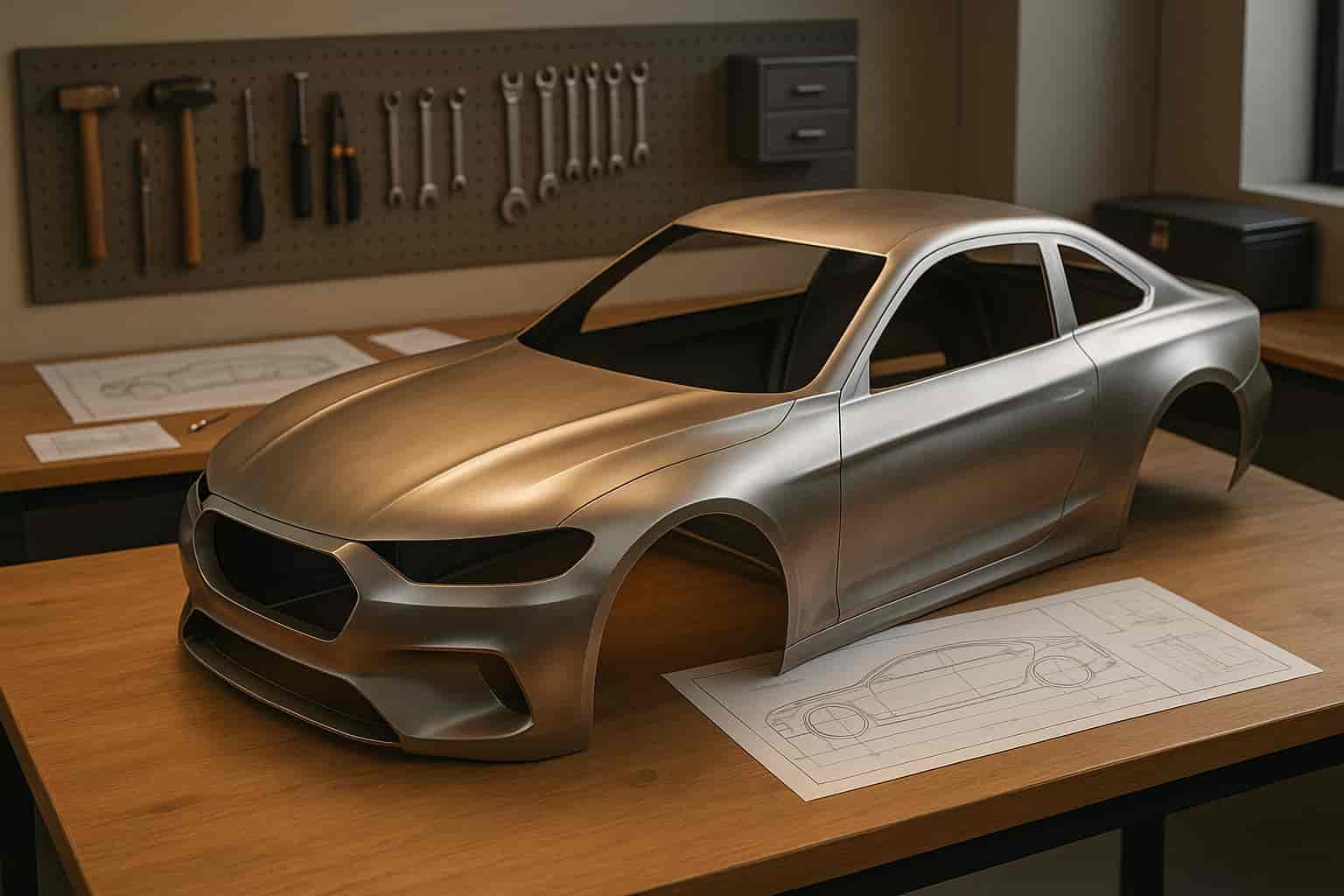










Abstract
The automotive industry, characterized by relentless competition, stringent regulations, and ever-accelerating product cycles, stands as a prime beneficiary of the manufacturing revolution ushered in by Rapid Prototyping Tooling (RPT). This in-depth analysis explores the critical application of RPT across the entire automotive product development lifecycle. It moves beyond simple prototype fabrication to examine how RPT—encompassing both indirect and direct methods—is utilized for functional validation, manufacturing process verification, custom assembly aid production, and even low-volume end-use part manufacturing. The article provides a detailed examination of specific technologies like Vacuum Casting, Direct Metal Laser Sintering (DMLS) for conformal-cooled molds, and sand casting for powertrain components. It further analyzes the profound impact of RPT on key industry trends, including vehicle electrification, lightweighting, and mass customization. Finally, the discussion addresses the persistent challenges and future trajectory of RPT, positioning it not merely as a supportive tool but as a core strategic enabler for agile, innovative, and efficient automotive manufacturing.
The modern automotive industry operates under immense pressure. Consumer demands for new features, connected services, and varied powertrains (electric, hybrid, internal combustion), combined with global safety and emissions regulations, have compressed vehicle development cycles from 5-7 years to as little as 2-3 years. In this high-stakes environment, the traditional approach to tooling—involving months of lead time and millions of dollars in investment for hardened steel molds and dies—represents a significant bottleneck and a substantial financial risk.
Any design flaw found after committing to production tooling can result in catastrophic costs and delays. This reality has made agility and iterative validation paramount. Rapid Prototyping Tooling has emerged as the pivotal technology answering this call. RPT in the automotive context refers to the use of advanced, digitally-driven manufacturing techniques to rapidly create the tools necessary to produce functional components for testing, validation, and low-rate production. Its application is multifaceted, spanning from conceptual design studios to the final assembly line.
This article will dissect how RPT is fundamentally reshaping how cars are designed, developed, and built, providing automakers and their suppliers with a critical competitive edge.
RPT is not a monolithic process but a suite of technologies applied at different stages with distinct objectives. Its integration into the automotive New Product Introduction (NPI) process can be visualized as follows:
Phase 1: Concept Design & Engineering Verification
Goal: To quickly and inexpensively assess the form, fit, and basic function of a component.
RPT Application: Low-volume production of concept models, often using indirect methods like Silicone Molding (Vacuum Casting) to create multiple copies of a part from 3D-printed masters. Parts are used for design reviews, ergonomic studies, and mock-up assemblies.
Phase 2: Functional Validation & Testing
Goal: To subject components to real-world conditions, testing their performance, durability, and material properties.
RPT Application: Production of parts using materials that closely mimic final production plastics or metals. This involves direct 3D printing of parts in high-performance materials (e.g., SLS Nylon, DMLS Aluminum) or using RPT-made molds to injection mold parts from engineering-grade thermoplastics (e.g., ABS, Nylon, Polypropylene).
Phase 3: Manufacturing Process Validation
Goal: To verify the production tooling and assembly processes before full-scale launch.
RPT Application: The creation of bridge production tools. These are often metal molds (via DMLS) used to produce several hundred to a few thousand parts for pilot builds, crash testing, marketing campaigns, and early field testing. This de-risks the final investment in massive production tooling.
Phase 4: Production & Assembly Support
Goal: To support the final vehicle assembly process.
RPT Application: Fabrication of custom jigs, fixtures, and assembly aids. These are tools used on the assembly line to hold parts in place, guide workers, or ensure precision. 3D printing these tools allows for rapid iteration and customization, improving line flexibility and ergonomics.
3.1 Interior Components: The Hub of User Experience
The vehicle interior is a primary differentiator for consumers, demanding a blend of aesthetics, ergonomics, and functionality. RPT is extensively used here.
Application Example: A Center Console Cluster
Challenge: Validate the fit of multiple components (screen, buttons, vents), the tactile feel of buttons, and the durability of living hinges and snap-fits.
RPT Solution:
Master Pattern: A high-resolution SLA or Material Jetted model of the console is printed, post-processed to a smooth finish.
Silicone Mold: A multi-part silicone mold is created from the master.
Vacuum Casting: Using polyurethane resins that mimic the look and feel of ABS or PC/ABS, multiple copies are cast. These parts are used for:
Fit-and-Function: Assembling the console with real screens and wiring harnesses in a prototype vehicle.
Durability Testing: Cycling buttons and lids thousands of times.
Consumer Clinics: Gathering feedback on design and usability.
Advanced Application: Urethane Casting for Soft-Touch Surfaces
For parts like dashboard tops or door panels with soft-touch surfaces, vacuum casting with flexible urethanes can create realistic prototypes that accurately represent the final product's haptic properties.
3.2 Under-the-Hood and Powertrain Components: Demanding Functional Validation
Components in the engine bay face extreme temperatures, chemical exposure, and mechanical stress. RPT must deliver parts that can withstand these conditions for meaningful testing.
Application Example: Engine Intake Manifold
Challenge: Test the manifold for airflow efficiency, heat resistance, and resistance to under-hood chemicals and vibration.
RPT Solution: Direct 3D Printing and Rapid Tooling for Casting.
Direct Metal Laser Sintering (DMLS): The manifold can be directly 3D printed in aluminum (AlSi10Mg) or titanium. This is ideal for a one-off functional prototype for a dyno test, but can be expensive for multiple units.
Rapid Sand Casting (Indirect Tooling): This is a highly prevalent method.
A 3D printer using Binder Jetting technology directly prints the sand mold and cores for the intake manifold.
These 3D-printed sand molds are then used in a traditional foundry. Molten aluminum is poured into the mold, the sand is broken away, and a fully metallic, functional intake manifold is produced.
Rapid Injection Molding: For plastic manifolds or components like engine covers, a direct metal (DMLS) mold insert made from tool steel can be used in an injection molding machine to produce parts in high-temperature, glass-filled nylons (e.g., PA6-GF). This is essential for validating the part under real thermal loads.
The Conformal Cooling Revolution in Powertrain Molds:
When using DMLS to create injection molds for large engine components like the cylinder head cover, engineers can design conformal cooling channels. These channels follow the complex contours of the part cavity, unlike traditional straight-drilled channels. This results in:
Up to 50% faster cycle times due to uniform and efficient heat dissipation.
Reduced part warpage and internal stresses, leading to higher quality and more dimensionally stable parts.
Extended mold life by minimizing thermal fatigue on the tool steel.
3.3 Exterior Body and Lighting: Aerodynamics, Safety, and Aesthetics
Exterior parts are large, often Class-A surfaces, and are subject to strict safety standards.
Application Example: Front Bumper Fascia
Challenge: Create a prototype bumper for aerodynamic testing, pedestrian safety compliance evaluation, and fitment with headlights and grille.
RPT Solution:
Large-Format Additive Manufacturing (LFAM): For a single, large part like a bumper, technologies that print with pellets of ABS or composite materials can produce the main structure very quickly and cost-effectively.
Rapid Tooling for Reaction Injection Molding (RIM): For a more robust part that mimics the production material (often polyurethane), a large, low-pressure mold can be created using an epoxy composite or a directly 3D-printed polymer. This mold is then used in a RIM process to produce a bumper with excellent impact properties, suitable for pedestrian safety testing.
Application Example: Tail Light Housing
Challenge: Validate the optical properties, seal integrity, and heat dissipation of the housing.
RPT Solution: Multi-Jet Fusion (MJF) or SLS. These technologies can produce housings in materials like PA12, which can be vapor-smoothed to be translucent or opaque as needed. This allows for testing the light diffusion and assembly with lenses and gaskets long before the expensive injection molds for the final part are cut.
3.4 The Unsung Hero: Customized Jigs, Fixtures, and Assembly Aids
Beyond part production, RPT's most immediate and impactful application is on the factory floor.
Application Examples:
Welding Jigs: 3D-printed fixtures that hold body-in-white panels in perfect alignment for robotic welding. They are lighter, cheaper, and can be produced in days instead of weeks.
Cable Routing Guides: Ergonomic tools that help assembly line workers route complex wiring harnesses correctly through the vehicle's body, reducing errors and assembly time.
Kitting Containers: Custom containers that hold specific parts for a particular vehicle variant, ensuring the right parts arrive at the assembly station just-in-time.
End-of-Arm Tooling (EOAT): Lightweight, optimized grippers for robots, 3D-printed in carbon-fiber composites, which increase robot speed and efficiency.
The benefits here are profound: cost savings of 70-90% lead time reduction of over 80%, and the ability to continuously improve tools based on operator feedback.
RPT is not just supporting existing processes; it is actively enabling the industry's most significant transformations.
4.1 Electric Vehicles (EVs)
The rapid evolution of EV platforms demands unprecedented agility. RPT is crucial for:
Battery Module Housings and Trays: Producing functional prototypes for thermal management testing, sealing validation, and crashworthiness analysis using DMLS (aluminum) or large-format SLS (plastic).
Electric Motor Components: Prototyping housings, stators, and heat sinks. 3D-printed conformal cooling channels in motor housings are a key area of research for thermal management.
Unique Interior Reconfigurations: With the absence of a transmission tunnel, EV interiors are being radically redesigned. RPT allows for rapid iteration of new console designs, seating arrangements, and user interfaces.
4.2 Lightweighting
The pursuit of fuel efficiency and extended EV range makes weight reduction critical. RPT facilitates this through:
Topology Optimization: Software generates organically-shaped, minimal-weight parts. These complex, often lattice-filled, structures are frequently impossible to manufacture traditionally but are ideal for 3D printing.
Part Consolidation: RPT allows for the design and validation of a single, complex component that replaces an assembly of multiple parts, eliminating fasteners and reducing weight. A 3D-printed bracket that consolidates ten smaller parts is a common example.
4.3 Mass Customization
The future of automotive lies in personalized vehicles. RPT makes low-volume production economically viable.
Customized Interior Accents: Unique vent covers, speaker grilles, or dashboard inlays can be produced in small batches using rapid tooling, allowing for personalization options without the need for massive, expensive molds for each variant.
Despite its advantages, the application of RPT in the automotive industry faces specific hurdles:
Scale and Throughput: While excellent for prototypes and low volumes, RPT cannot match the speed of a multi-cavity production mold churning out a part every 15 seconds for a production run of 500,000 vehicles.
Material Property Gaps: Although materials are continually improving, 3D-printed plastics or cast metals may not always have the exact long-term durability, UV stability, or creep resistance of their production-grade counterparts.
Certification and Standardization: The automotive industry has rigorous quality and traceability standards (e.g., IATF 16949). Qualifying a new manufacturing process like DMLS for a safety-critical component requires extensive and costly testing and documentation.
High-Volume Cost: For parts needed in the thousands, the per-part cost of RPT methods can still be higher than that of mass-production injection molding.
The trajectory of RPT points toward even deeper integration:
Digital Twins and Smart Tooling: Mold inserts will be equipped with sensors, creating a "digital twin" of the tool. Real-time data on temperature, pressure, and wear will be used for predictive maintenance and process optimization.
Advanced Multi-Material Printing: The ability to print with multiple materials in a single build will allow for tools with integrated conformal cooling channels made from a highly conductive material, while the bulk of the mold is a less expensive, sturdy material.
AI-Driven Generative Design for Tooling: Artificial Intelligence will not only optimize the part design but also automatically generate the most efficient mold design, with perfect cooling channels and minimal weight, pushing the boundaries of tooling performance.
Sustainable Manufacturing: RPT promotes sustainability by reducing material waste (additive vs. subtractive processes) and enabling local, on-demand production of tools and parts, slashing transportation-related emissions.
Rapid Prototyping Tooling has irrevocably shifted the paradigm of automotive development. It has evolved from a niche technique for model makers to a strategic capability embedded across design, engineering, and manufacturing. By providing unparalleled speed, flexibility, and cost-efficiency for low-volume production, RPT empowers automakers to innovate more boldly, validate more thoroughly, and de-risk their massive capital investments. It is a key enabler for the industry's transition to electric, connected, and personalized vehicles. While challenges in volume and certification remain, the ongoing convergence of additive manufacturing, digitalization, and new materials ensures that RPT will continue to accelerate its journey from the prototype lab to the very heart of automotive production, driving the industry forward into a more agile and innovative future.